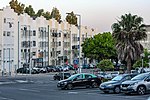Oeiras, Portugal

Oeiras (Portuguese pronunciation: [oˈɐjɾɐʃ] (listen)) is a town and municipality in the western part of Lisbon metropolitan area, located within the Portuguese Riviera, in continental Portugal. The municipality is part of the urban agglomeration of Lisbon and the town of Oeiras is about 16 km from Lisbon downtown. The population in 2011 was 172,120 living in an area of 45.88 km2, making the municipality the fifth-most densely populated in Portugal. Oeiras is an important economic hub, being one of the most highly developed municipalities of Portugal and Europe. It has the highest GDP per capita in the country, being also the second highest-ranking municipality (immediately after Lisbon) in terms of purchasing power as well as the second highest-ranking in the country as far as tax collection is concerned. These economic indicators also reflect the education level of its inhabitants, as Oeiras is the municipality with the highest concentration of population by tertiary education attainment in the country, their entrepreneurial prowess and the economically liberal mindset of Oeiras' society in general. It also has the lowest unemployment rate in the Lisbon area.
Excerpt from the Wikipedia article Oeiras, Portugal (License: CC BY-SA 3.0, Authors, Images).Oeiras, Portugal
Avenida Dom João I, Oeiras e São Julião da Barra, Paço de Arcos e Caxias
Geographical coordinates (GPS) Address Nearby Places Show on map
Geographical coordinates (GPS)
| Latitude | Longitude |
|---|---|
| N 38.683333333333 ° | E -9.3166666666667 ° |
Address
Escola EB 2,3 de São Julião da Barra
Avenida Dom João I
2780 Oeiras e São Julião da Barra, Paço de Arcos e Caxias
Portugal
Open on Google Maps








